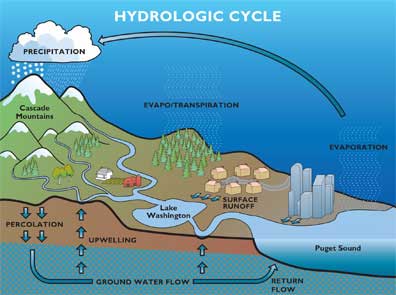Hydrologic cycle as an ecological function
What is the hydrologic cycle?
The hydrologic -- or water -- cycle is the continuous movement of water between the earth and the atmosphere. Water reaches land as precipitation such as rain and snow. Then the water evaporates, condenses in the atmosphere to form clouds, and falls to the earth again as precipitation, continuing the cycle.
When water falls to the ground it can collect on the land becoming streams, rivers, lakes, or soaks in to the ground to become groundwater. Plants take up groundwater either using it or releasing it to the atmosphere.

Why is the hydrologic cycle important?
The hydrologic cycle is important because it is how water reaches plants, animals and us! Besides providing people, animals and plants with water, it also moves things like nutrients, pathogens and sediment in and out of aquatic ecosystems.
Ways in which the hydrologic cycle is affected
One of the ways that water moves through the cycle is through its ability to permeate, or soak, into the soil. There are four key areas that impact that part of the cycle:
- changes in the ability of soil to soak up water through increases of impervious surfaces, like roads and buildings, and removal of forest cover;
- water withdrawals or impoundments (such as through wells or dams)
- filling depressional wetlands;
- and altering stream flows and beds.
References: Booth et al 2002; Reinelt and Taylor 1997
Shoreline videos: Life on the Edge
Related information
- Animals, plants and habitat
- King County wetland resources
- King County watersheds
- Puget Sound marine information

 Translate
Translate